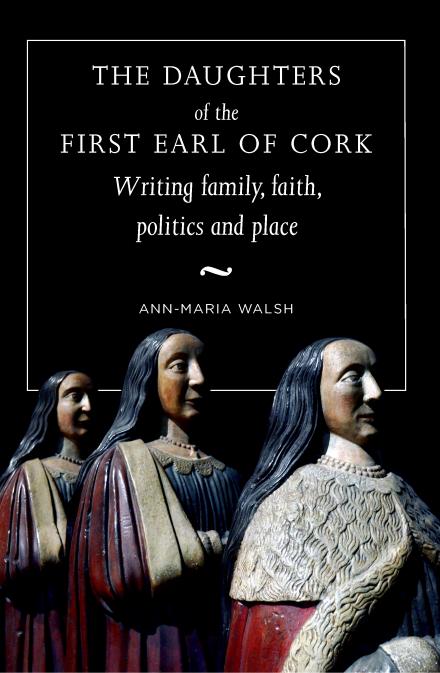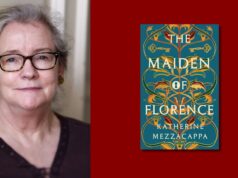Ann-Maria Walsh reflects on how she first discovered the fascinating story of the Boyle Family.

My first encounter with the seventeenth-century Boyle women was entirely accidental. In October 2012 I was due to attend a workshop in Marsh’s Library as part of my MA studies at University College Dublin and, having arrived early, I decided to pay a quick visit to St Patrick’s Cathedral, which is located nearby. Immediately inside the cathedral doors stands the 32-foot-high Boyle monument that was first erected in 1632 at the behest of Richard Boyle, 1st earl of Cork (1566–1643), to honour his wife, Katherine Boyle, 1st countess of Cork (c. 1588–1630), who had died on 16 February 1630.
As the second son of a Canterbury gentleman, Richard Boyle had to create his own destiny and in 1588 he arrived on Irish shores as part of a posse of administrators tasked with the plantation of Munster. Using his legal training, Boyle travelled around the Munster region checking land titles and re-assigning forfeitures to the crown. Boyle also used those same occasions to accumulate his own parcels of land, and by the 1640s conservative estimates suggest that he was one of the richest men in the three kingdoms.
Before achieving that level of success, the 25th of July 1603 stands out as a defining moment in Boyle’s career trajectory because it marks the same day that he was awarded a knighthood and married Katherine Fenton, only daughter of Sir Geoffrey Fenton, who was secretary of state for Ireland. Katherine brought with her a dowry of £1,000, which enabled her new husband to purchase Sir Walter Raleigh’s 42,000-acre estate in Fermoy, Co. Cork.
In addition to creating a permanent base in Munster, the Boyles also set about establishing a dynasty of their own, and between 1606 and 1629 Katherine Boyle gave birth to fifteen children, twelve of whom survived into adulthood—seven daughters (Alice, Sara, Lettice, Joan, Katherine, Dorothy and Mary) and five sons (Richard, Roger, Lewis, Francis and Robert). All of the male members of the Boyle family are featured in the monument at St Patrick’s, and many of those individuals were significant players during the seventeenth century in both Ireland and Britain. Yet, I was more immediately struck by the six kneeling female figures, representing Boyle’s daughters, who are positioned at eye-level at the very base of the tomb. As someone from Cork, I was intrigued about these early modern sisters and what they had thought about their own lives and what it was like to be a member of their seemingly famous family, based on both the prominence and the scale of their highly ornate tomb.
The monument inspired me to continue studying and my research led me to discover that a rich archival legacy had also been preserved in memory of the Boyle family. Those extant manuscript materials can be found in the national libraries of Ireland, England and Scotland, as well as in various other repositories and in the private archives of a number of stately homes.
The women’s portion of the family’s surviving papers is surprisingly rich, varied and voluminous, and includes letters, a diary, an autobiography, a memorandum book, recipe and accounts books, a prose treatise and pious meditations. I learned from re-reading those texts that the Boyle women were fastidious about record-keeping. They also frequently took on the role of custodian of the family’s important documents, especially at critical junctures including, for instance, during the Irish and English civil wars when the Boyles experienced besiegement, displacement and exile. It is clear from the family’s surviving papers that a strong literary culture flourished within and among the different generations of Boyles, but letter-writing was primarily a life-skill that the women practised on an everyday basis as part of managing their families, households and landed estates. Letter-writing also allowed the women to remain connected, particularly given that travel and long separations were the norm for the Boyles, with relatives, friends, property, business and political interests situated on both sides of the Irish Sea.
From the 1st countess of Cork to her granddaughter, the extant letters reflect a shared understanding that writing and self-fashioning were key to establishing a separate identity and at the same time allowing for the development and maintenance of a worthy reputation both within and outside of the kinship group. The act of writing also seems to have provided catharsis for the women by affording them an audience to whom they could voice their fears and anxieties about matters of deep personal concern, such as their children falling dangerously ill from infectious diseases.
The family correspondence network also served as a life-line for the women, enabling them to seek help to ease their difficulties and, in doing so, empowering them to take some control over their lives. The more explicitly autobiographical texts such as the diary, the autobiography and the memorandum book also illuminate how the women wished to be remembered into the future: as active participants in the historic events of the period; as important contributors to the family’s fortunes; as devout Protestants; and as legacy-makers in their own right.
Thus, by retrieving and critically evaluating this collection of largely forgotten female-voiced texts, a much more fulsome understanding can be reached about how these Irish-born women imagined and wrote their lives throughout the turmoil of the seventeenth century, while also shedding new light on the kind of impact this family of women made in their local communities and across society, politics, religion, culture, medicine, science and philosophy.
***

About the author:
Ann-Maria Walsh studied English at University College Dublin and was awarded her Ph.D in 2017. Her monograph, The Daughters of the First Earl of Cork: writing family, faith, politics, and place was published by Four Courts Press in February 2020. She has an essay on the Boyle women in Women’s Life Writing and Early Modern Ireland, edited by Julie Eckerle and Naomi McAreavey (University of Nebraska Press, 2019). Ann-Maria was awarded a 2019 Marie Curie Individual Fellowship and is currently working on an edition of the Boyle women’s extant letters for the Irish Manuscripts Commission.
The daughters of the first earl of Cork:Writing family, faith, politics and place.
Published by Four Courts Press. 178pp. Colour Ills. Hardback. €50. Available Now: https://www.fourcourtspress.ie/books/2020/the-daughters-of-the-first-earl-of-cork/













